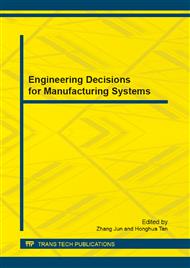[1]
Siqun Ma, Yanbin Sun, Shaoze Zhou, Xiaopeng Wu: Research on Structure Security Evaluation and Fault Diagnosis of Gate Crane Jib (2009 IITA International Conference on Control, Automation and Systems Engineering. Dalian, China. 2009), pp.359-363.
DOI: 10.1109/case.2009.166
Google Scholar
[2]
Stian Ruuda, Age Mikkelsen: Risk-based rules for crane safety systems (ScienceDirect Journal, "Reliability Engineering and System Safety 93, Elsevier Science Ltd. USA. 2008), p.1369–1376.
DOI: 10.1016/j.ress.2007.08.004
Google Scholar
[3]
Gyeondong Baek, Kangkil Kim, and Sungshin Kim: Optimal Preventive Maintenance Inspection Period on Reliability Improvement with Bayesian Network and Hazard Function in Gantry Crane (Springer-Verlag Berlin Heidelberg Germany. 2009), pp.1189-1196.
DOI: 10.1007/978-3-642-01513-7_132
Google Scholar
[4]
F. Omar, F. Karray, O. Basir and L. Yu: Autonomous Overhead Crane System Using a Fuzzy Logic Controller ( Journal of Vibration and Control, Virginia Polytechnic Institute and State University, U. K. 2004), pp.1255-1270.
DOI: 10.1177/1077546304042038
Google Scholar
[5]
Liu Changhui, Liu Le: Based on 32 tons Crane for Wireless Remote Control System Design (2008 IEEE Pacific-Asia Workshop on Computational Intelligence and Industrial Application. Wuhan, China. 2008). pp.449-453.
DOI: 10.1109/paciia.2008.405
Google Scholar
[6]
Ming Wang, Guiqing Zhang, Qiao Yan, Bin Shen, Liyan Yuan, Liang Liu: Development of a Novel Black Box for Tower Crane Based on an ARM-based Embedded System (Proceedings of the IEEE International Conference on Automation and Logistics, Jinan, China, 2007), pp.82-87.
DOI: 10.1109/ical.2007.4338535
Google Scholar
[7]
Yongxiang Zhao, Aing Gao: A General Isodegrading Model for Predicting Mechanical Equipment Eeliability and Performance Degradation (Microelectron Reliability Journal, Vol. 38, Elsevier Science Ltd. 1998), pp.427-434.
DOI: 10.1016/s0026-2714(97)00060-7
Google Scholar
[8]
K-D. Meck and G. Zhu: Improving mechanical seal reliability with advanced computational engineering tools (John Crane EAA, Manchester, UK. 2008), pp.7-10.
Google Scholar
[9]
Heqing Li, Qing Tan: Reliability Analysis of Hydraulic System for Type Crane Based on Go Methodology (2009 Second International Conference on Intelligent Computation Technology and Automation. computer society, IEEE. 2009), pp.876-879.
DOI: 10.1109/icicta.2009.447
Google Scholar


